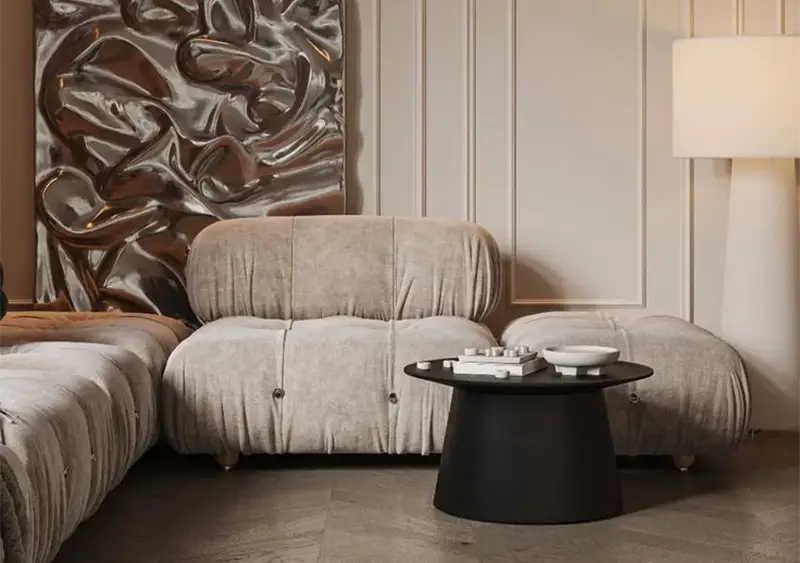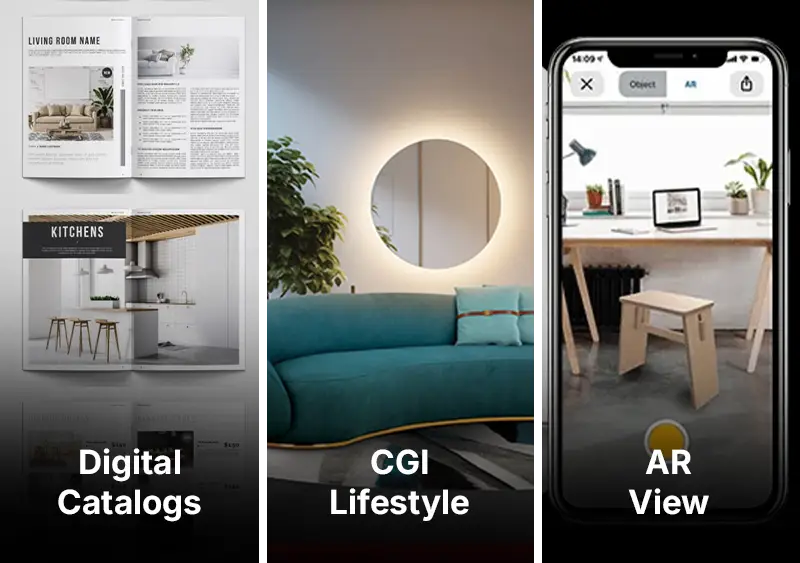Why US Furniture Brands Are Switching to 3D Visualization
3D helps furniture brands launch faster and sell smarter.

8 MIN READ
June 12, 2025

Written By
Allwyn Ruban
Introduction
Furniture is no longer sold just through catalog pages or showroom walk-ins. Today’s customers expect to spin, zoom, and explore every detail of a product before they even think about clicking “Add to Cart.”
That shift in buyer behavior is changing how brands work behind the scenes. Especially in the US, where the competition is fierce and the market moves fast, furniture companies are rethinking how they create, display, and scale their product visuals.
Many of them are moving away from traditional photoshoots and static mockups. Instead, they’re investing in 3D visualization services not as an experiment, but as a core part of how they launch and sell.
This blog explains the factors causing that change, why it will pick up speed in 2025, and how some of the largest furniture brands are utilising 3D to remain ahead of the competition.
How 3D Visualization Solves Real Problems for Furniture Brands?
For most furniture brands, it’s a way to solve problems they’ve been dealing with for years delays, production costs, inconsistent visuals, and too many versions of the same thing.
Here’s how 3D changes the workflow in ways that actually matter.
1. No More Waiting on Prototypes
Before, teams had to wait for physical samples to be made, shipped, and styled before marketing could even begin. That process often delayed product launches by weeks.
With 3D, renders are ready while the real product is still in development.
Marketing can go live sooner. Product pages can be built earlier. Campaigns don’t have to wait on factory timelines.
And if you're thinking about taking the next step, check out this guide on outsourcing 3D visualization. It walks you through how brands are streamlining their entire content pipeline with the right offshore partner.
2. Scale Variations Without Shooting Everything Again
New leg style? Different finish? Another fabric color? Normally, every one of those would require a new photoshoot or expensive post-editing.
But with 3D, once the core model is built, changing materials or colors is fast and doesn’t cost extra in production time. Brands can launch dozens of visual variants without building a single new set.
3. Reduce Visual Inconsistency Across Platforms
Furniture often looks one way on the website and completely different in print or ads. That’s because different teams shoot or crop images separately.
3D renders offer controlled consistency every angle, light source, and styling choice can match across every output, from your Shopify store to a Pinterest ad campaign.
4. Cut Down on Storage and Logistics Costs
Without 3D, teams often produce multiple prototypes, store them, ship them to studios, and sometimes discard them after a shoot. That’s a hidden cost most teams don’t even track.
With digital visuals, those logistics disappear.
You don’t need a warehouse to support a photo shoot. You just need a good rendering pipeline.
Real Examples of What Brands Are Doing Differently Now
Furniture brands used to rely on physical spaces and expensive photoshoots to sell their products. But in 2025, the shift to digital-first selling has pushed many of them to rethink how they show, scale, and sell.
Let’s look at the kinds of changes brands are making not just to save money, but to work faster, market smarter, and meet buyer expectations head-on.

1. Virtual Catalogs Are Replacing Printed Lookbooks
Many leading US furniture brands are phasing out traditional seasonal lookbooks.
Instead of staging, printing, and shipping brochures, they’re launching fully digital catalogs powered by 3D renders.
These catalogs are lightweight, mobile-friendly, and can showcase every fabric, finish, and frame combination in ultra-high clarity without printing a single page.
Some even integrate interactive product viewers that let retailers explore the product in 360° right from the catalog PDF or link.
2. CGI Lifestyle Scenes Are Replacing Studio Photos
Brands used to rent studios, stage room scenes, and spend days getting the right lighting and composition.
Now, they commission CGI lifestyle renders beautifully designed interior environments that showcase the product in context. These scenes are fully digital but feel real enough for social ads, hero banners, and even billboard displays.
The benefit? You can reuse the same scene across multiple SKUs or instantly update the sofa while keeping the room intact. That’s impossible in traditional photography.
3. AR and Room Visualization Tools Are Becoming Standard
Customers want to see how a product fits into their actual space before buying. That’s why more brands are integrating AR (augmented reality) tools that are powered by 3D assets.
Apps like Shopify AR and custom-built experiences let shoppers place a true-to-scale model of a chair, table, or cabinet in their home using just their phone.
The foundation for this tech is 3D furniture rendering once you have the models, they can be adapted for AR, VR, or even future retail platforms.
Why the US Market Is Leading This Shift
While 3D visualization is growing globally, the US furniture industry has moved faster than most. What’s driving this early adoption isn’t just access to better tech, it's a combination of high consumer expectations, rising operating costs, and market pressure to stay ahead of trends.
Here’s what makes the US market a leader in the shift to 3D.
1. Strong eCommerce Growth in Furniture Sales
US-based furniture brands are investing more in digital channels every year. According to Statista, Online furniture sales in the US generated around $120 billion in 2023.
By 2027, the market is forecasted to exceed $118 billion in revenue.
This reflects strong growth from approximately $90 billion in 2022 to over $118 billion by 2027
This rapid shift to eCommerce means brands must replicate the showroom experience online. That’s where 3D visualization helps create a shopping experience that’s visual, dynamic, and confidence-building.
2. Rising Studio and Logistics Costs
The cost of physical photoshoots has continued to rise in the US especially with inflation, higher warehousing rates, and increasing creative production costs.
A 2024 survey by Shopify Plus found that 62% of mid-market retailers in the US planned to reduce reliance on traditional product photography by adopting 3D or CGI visuals.
For many brands, 3D is not just a better creative option it’s also a smarter financial decision.
3. Competitive Pressure from D2C Startups
The D2C furniture boom in the US has created faster, more agile brands like Burrow, Floyd, and Article all of which use 3D renders for launching SKUs, testing new products, and running omnichannel campaigns.
Legacy players are now under pressure to modernize their processes and match the speed, flexibility, and personalization options these startups deliver.
3D rendering is one of the easiest levers to pull to level the playing field without overhauling internal operations.
4. Tech-Forward Retail Infrastructure
The US already leads in digital commerce tech. Platforms like Shopify, BigCommerce, and Adobe Commerce offer 3D and AR integrations natively, and tools like Sketchfab and Threekit are helping more brands deploy 3D faster.
The ecosystem is ready. Most US brands just need to plug into it—which makes the switch smoother and less risky compared to other regions.
5. Consumer Expectations Are Higher Than Ever
American shoppers expect more control when buying online. A 2023 McKinsey report noted that 70% of US consumers expect personalization when browsing for home and lifestyle products, and 3D-powered configurators directly enable that.
The pressure to deliver tailored, interactive product experiences is pushing brands to leave traditional visuals behind.
Final Thoughts:
This shift to 3D isn’t about chasing a trend. It’s a response to how customers actually shop, how fast brands need to launch, and how expensive old workflows have become.
In the US, the brands making the biggest moves are the ones that saw this early and adapted.
They didn’t wait for the future of furniture retail. They rendered it, styled it, and published it while others were still planning photoshoots.
3D furniture visualization isn’t replacing creativity. It’s freeing it up. And in a market that moves this fast, that freedom makes all the difference.
Ready to move past photoshoots, delays, and outdated visuals? ZealousXR helps furniture brands turn concepts into clickable, scroll-stopping renders fast. Let’s build your product visuals like the industry already has.
About the writer :
Allwyn Ruban heads business development and marketing at Zealous Services. He’s the go-to person for finding smart ... ways to grow their 3D services, from animation to modeling. With a knack for digital strategy, Allwyn is all about helping clients achieve their goals while expanding Zealous' reach in the industry. His friendly approach makes collaboration easy and effective.
Read MoreFrequently Asked Questions (FAQ)
Do 3D furniture renders actually look real enough for customers to trust?
Yes. When done right, 3D renders can be nearly indistinguishable from high-end product photography. The materials, lighting, and shadows are all digitally controlled, so the end result often looks more polished and consistent than traditional photos.
Can I still use 3D visuals across multiple platforms?
Absolutely. 3D renders are highly flexible. You can export them for web, print, social media, digital ads, catalogs, and even AR or virtual showroom applications. One model can serve dozens of visual formats.
Is 3D visualization only useful for custom or configurable furniture?
Not at all. Even for fixed SKUs, 3D allows faster launches, better lifestyle imagery, and cleaner product detail pages. But if you offer customization—like fabrics, finishes, or leg options it becomes even more valuable.
How long does it take to get a full furniture collection rendered?
Timelines vary based on complexity and number of products, but most brands can get an entire collection visualized within 1 to 3 weeks. Once the base model is created, generating variations is much faster.